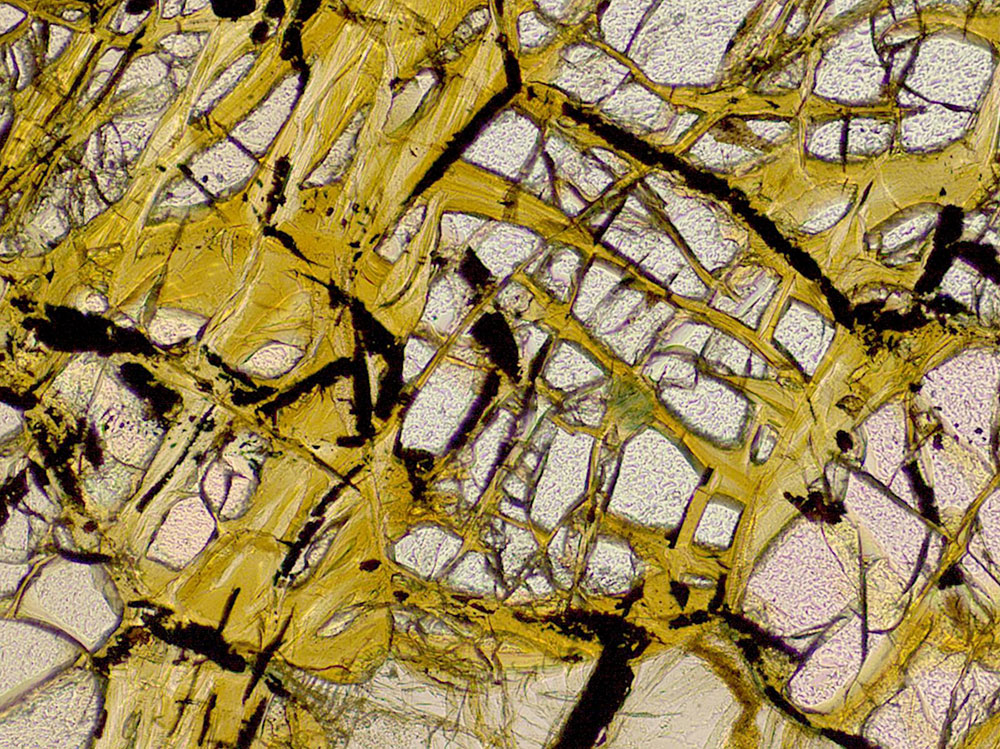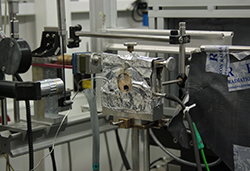How to produce enough hydrogen to meet global energy needs (in 50 years)
December 10, 2013

Partial serpentinization of olivine (in yellow), releasing hydrogen (credit: Bernard Evans, University of Washington)
In a few decades, it could even help the world meet key energy needs.
Here’s the recipe, according to University Claude Bernard Lyon 1 researchers:
1. In a microscopic high-pressure cooker called a diamond anvil cell (within a tiny space about as wide as a pencil lead), combine these ingredients: aluminum oxide, water, and the mineral olivine.
2. Set at 200 to 300 degrees Celsius and 2 kilobars pressure — comparable to conditions found at twice the depth of the deepest ocean.
3. Cook for 24 hours.
[+]
4. Collect the hydrogen produced when water meets the ubiquitous
mineral olivine under pressure (normally in a rock) and the mineral
reacts with oxygen atoms from the H2O, transforming olivine
into another mineral, serpentine — characterized by a scaly, green-brown
surface appearance like snake skin.
A
diamond anvil cell capable of compressing aluminum oxide, water, and
the mineral olivine under high pressure and at 200 to 300 degrees C to
release hydrogen (credit: Herve Cardon, University of Lyon-1)
That process also splits hydrogen (H2) from the oxygen atoms in water.
The Lyon experiments produced hydrogen some 7 to 50 times faster than the natural “serpentinization” of olivine.
Says Jesse Ausubel of The Rockefeller University and Deep Carbon Observatory (DCO): “Scaling this up to meet global energy needs in a carbon-free way would probably require 50 years. But a growing market for hydrogen in fuel cells could help pull the process into the market.”
Until now, it has been a scientific mystery how the rock + water + pressure formula produces enough hydrogen to support such an abundance of chemical-loving microbial and other forms of life abounding in the hostile environments of the deep, says DCO scientist Isabelle Daniel. “We believe the serpentinization process may be underway on many planetary bodies — notably Mars.”
A deep subterranean microbe network
Meanwhile, the genetic makeup of Earth’s deep microbial life is being revealed through DCO research underway by Matt Schrenk of Michigan State University and many other associates.
At DCO scientist presentations at the AGU Fall Meeting in San Francisco (Dec. 9–13), the researchers will report the results of deep sampling from opposite sides of the world, revealing enigmatic evidence of a deep subterranean microbe network.
Says Schrenk: “It is easy to understand how birds or fish might be similar oceans apart, but it challenges the imagination to think of nearly identical microbes 16,000 km apart from each other in the cracks of hard rock at extreme depths, pressures, and temperatures.”
Among other major AGU presentations, DCO investigators will introduce a new model that offers new insights into water-rock interactions at extreme pressures 150 km or more below surface, well into Earth’s upper mantle. To now, most models have been limited to 15 km, one-tenth the depth.
The $500 million global DCO collaboration is led by Dr. Robert Hazen, a Senior Staff Scientist at the Carnegie Institution of Washington.
Abstract of American Minerologist paper
The reactivity of ultramafic rocks under hydrothermal conditions controls chemical fluxes at the interface between the internal and external reservoirs of silicate planets. On Earth, hydration of ultramafic rocks is ubiquitous and operates from deep subduction zones to shallow lithospheric environments where it considerably affects the physical and chemical properties of rocks and can interact with the biosphere. This process also has key emerging societal implications, such as the production of hydrogen as a source of carbon-free energy. To date, the chemical model systems used to reproduce olivine hydrothermal alteration lead to the formation of serpentine with sluggish reaction rates. Here, we use in situ diamond-anvil cell experiments and show that the presence of aluminum in hydrothermal fluids increases the rate of olivine serpentinization by one to two orders of magnitude. Aluminum increases the solubility of olivine and enhances the precipitation of aluminous serpentine. After two days, olivine crystals were fully transformed to aluminous serpentine under conditions typical for natural hydrothermal environments, i.e., 200 and 300 °C, 200 MPa. This result motivates a re-evaluation of the natural rates of olivine serpentinization and of olivine hydrolysis in general in a wide range of settings. This discovery also opens the potential of the serpentinization reaction for industrial scale production of hydrogen at economically feasible timescales and temperature.
(¯`*• Global Source and/or more resources at http://goo.gl/zvSV7 │ www.Future-Observatory.blogspot.com and on LinkeIn Group's "Becoming Aware of the Futures" at http://goo.gl/8qKBbK │ @SciCzar │ Point of Contact: www.linkedin.com/in/AndresAgostini
 Washington
Washington